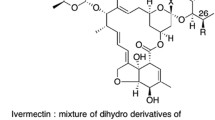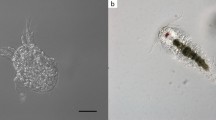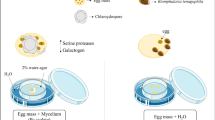Abstract
Three different benzimidazole derivatives, albendazole [methyl-5-(propylthio)-2-benzimidazolcarbamate], mebendazole (methyl-5-benzoyl-2-benzimidazolcarbamatic acid methyl ester), and fenbendazole [methyl-5-(phenylthio)-2-benzimidazolcarbamate] were tested in vivo against Glugea anomala parasitizing the connective tissue of sticklebacks (Gasterosteus aculeatus). Naturally infected sticklebacks were incubated in aerated plastic aquaria (10 l) at 22 °C in water containing 0, 1, 5, 10, or 50 μg of either albendazole, mebendazole or febendazole for 2 or 6 h. For intermittent treatment, 2 μg substance was administered three times for 6 h at intervals of 36 h. At the ultrastructural level, at all developmental stages of G. anomala there were no significant differences in the kind of damage caused by either albendazole, mebendazole, or febendazole. Starting with a dose of 1 μg/ml for 2 h, each of the drugs irreversibly damaged uni- and multinucleate meronts, sporogonial plasmodia, and sporoblasts. Disorganized spores were also observed. Treatment with higher doses (10 μg/ml, 2 or 6 h) caused malformations of the merogonic and the sporogonic stages, a significant reduction in the number of ribosomes, and disruptions of the nuclear membranes. The first recognizable treatment effect was an enlargement of the smooth endoplasmic reticulum. In the sporogonial plasmodia, the membranes of the sporophorous vesicle envelopes were lumpy or even completely destroyed. After incubation with the highest dose (50 μg/ml, 6 h), microtubules were apparent within the karyoplasm of the uninucleate meronts. After interval treatment, all forms of damage were intensified, especially in the mature spores. When treatment was done three times at low doses (3 × 2 μg/ml, 6 h, 36-h intervals), spore infectivity was drastically lowered. Therefore, it seems likely that an intermittent regimen of medicinal baths can be successfully applied against susceptible Microsporidia in fish.
Similar content being viewed by others
Author information
Authors and Affiliations
Additional information
Received: 8 May 1997 / Accepted: 19 May 1997
Rights and permissions
About this article
Cite this article
Schmahl, G., Benini, J. Treatment of fish parasites. 11. Effects of different benzimidazole derivatives (albendazole, mebendazole, fenbendazole) on Glugea anomala, Moniez, 1887 (Microsporidia): ultrastructural aspects and efficacy studies. Parasitol Res 84, 41–49 (1997). https://doi.org/10.1007/s004360050354
Issue Date:
DOI: https://doi.org/10.1007/s004360050354




